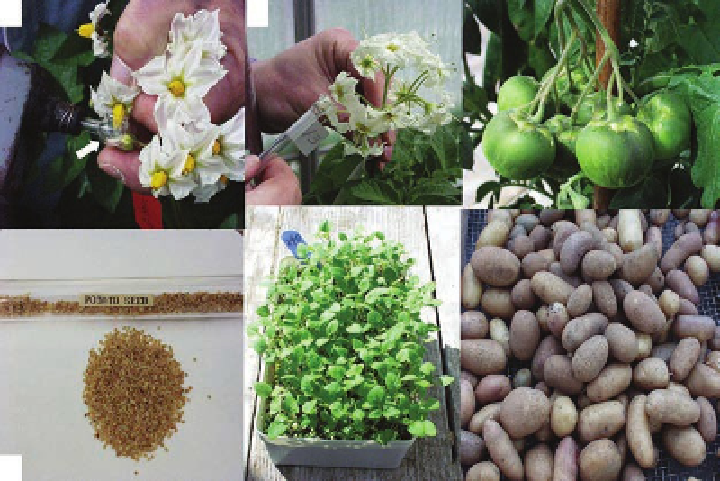Agriculture Reference
In-Depth Information
Cultivars or breeding clones used in hybridiza-
tions can, with few exceptions, be used as the fe-
male parent. However, this is not the case with
respect to male fertility, with sterility often being
an impediment with approximately
40-
50% of
parents displaying male sterilities. If a parent is
male fertile, an inflorescence—consisting of an
average of ten flowers—will be tagged on that
plant for the collection of pollen into glass vials
(Fig. 16.2a
)
. Pollen, if kept dry, can be stored for
up to a month at 2.5°C or
11-
12 months at -
20
to -24°C (Howard, 1958; Blomquist and Lauer,
1962). Other inflorescences on the same plant
can be used as female flowers, with their respective
anthers being removed (emasculated), allowing
for easier pollination of the stigma with pollen
from another male-fertile parent. Crossing tags,
placed by the breeder on the female inflores-
cence, detail the female and male parents used in
the cross and the date the tag was placed on the
inflorescence. Pollination of flowers typically is
done in the morning to early afternoon, after
flowers have opened and prior to the corolla clos-
ing by mid- to late afternoon (
Fig. 16.2
b). If suc-
cessful, a pollinated flower will swell at its base—
ovary—and develop into a fruit—also called a
berry—that looks like a small, green tomato
(
Fig. 16.2c)
, otherwise the flower will wither and
drop from the plant within
3-
5 days following
pollination. Plastic bags with air holes are tied
around each developing fruit cluster, with an ac-
companying crossing tag to ensure fruits do not
drop, with the parental background of the cross
subsequently being lost. Additional detail re-
garding hybridization of potato is also presented
by Plaisted (1993).
True potato seed
Potato fruits that form from successful hybrid-
izations contain true potato seed—to distinguish
from the more common reference to potato seed
that comprises a piece of a tuber containing an
eye. True potato seed looks very much like to-
mato seed (
Fig. 16.2d
)
, and is extracted from
mature potato fruits that have changed from
green to gray-green in color and have softened,
generally
5-7
weeks following hybridization.
True potato seeds in fruits are extracted in the
Aberdeen program using a blender with dulled
blades, with seeds then being sieved and dried.
Dried seed is stored in coin envelopes, with each
envelope representing a unique hybridization
(a)
(b)
(c)
(d)
(e)
(f)
Fig. 16.2.
(a) Pollen is collected in a glass vial (arrow) and used for pollination of emasculated flowers (b).
If successful, potato fruits develop (c), with true potato seed (TPS) extracted from mature fruit (d). Potato
seedlings from germinated TPS (e) develop into plants and tuberize, with harvested seedling tubers
(f) being planted in the field as single hills for selection the following year.



